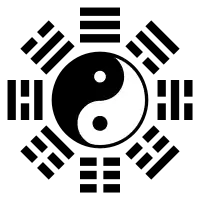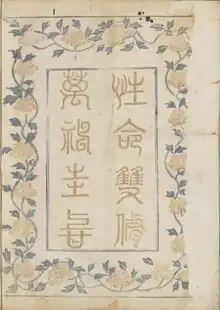 Xingming shuangxiu wanshen guizhi half-title page | |
| Author | Unknown |
|---|---|
| Original title | 性命雙修萬神圭旨 |
| Country | Ming dynasty (China) |
| Language | Chinese |
| Genre | Neidan, Daoism, Buddhism |
| Published | 1615 |
Original text | 性命雙修萬神圭旨 at Chinese Wikisource |
| Xingming guizhi | |||||||||||||||
|---|---|---|---|---|---|---|---|---|---|---|---|---|---|---|---|
| Chinese name | |||||||||||||||
| Chinese | 性命圭旨 | ||||||||||||||
| |||||||||||||||
| Korean name | |||||||||||||||
| Hangul | 성명규지 | ||||||||||||||
| Hanja | 性命圭旨 | ||||||||||||||
| |||||||||||||||
| Japanese name | |||||||||||||||
| Kanji | 性命圭旨 | ||||||||||||||
| Kana | せいめいけいし | ||||||||||||||
| |||||||||||||||
The Xingming guizhi (性命圭旨, Principles of Inner Nature and Vital Force) is a comprehensive Ming dynasty (1368-1644) text on neidan ("internal alchemy") self-cultivation techniques, which syncretistically quotes sources from the Three teachings of Daoism, Confucianism, and Buddhism (particularly the Yogachara school), and is richly illustrated with over fifty illustrations that later texts widely copied. The classic Xingming guizhi has been republished for over four centuries, from its first woodblock edition in 1615 to digital versions in the present.
Title
Xingming shuangxiu wanshen guizhi (性命雙修萬神圭旨, Principles of the Joint Cultivation of Inner Nature and Vital Force and of the Ten Thousand Spiritual Forces) is the full title of the Xingming guizhi (tr. Darga 2008: 1106). Shuangxiu (雙修) denotes the "joint cultivation" of xing ("inner nature") and ming ("vital force"), which is the objective of Neidan schools (Esposito 2008: 906). Although the Xingming guizhi promulgates the shuangxiu (雙修, "joint cultivation") of xing and ming, it does not attach much importance to physiological practices and emphasizes the spiritual aspects of inner transformation (Darga 2008: 1107).
Both titles use the common Chinese word xìngmìng (性命, "life"; 8.9 average occurrences per million characters of text, Bishop 2016), and the rare, if not nonce, word guizhi (圭旨).
Xingming
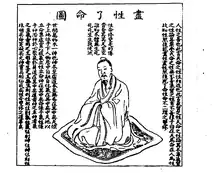
Unlike guizhi, xingming is found in Chinese dictionaries. For instance, the unabridged monolingual Hanyu Da Cidian (Comprehensive Chinese Word Dictionary), which is lexicographically comparable to the Oxford English Dictionary, defines three meanings for xingming:
- 中国古代哲学范畴。指万物的天赋和禀受。 [Ancient Chinese philosophical category. It refers to the natural talents and endowments of all living things.]
- 生命。 [Life.]
- 本性。 [Natural character; inherent quality; original nature.] (Luo 1994 7: 477–478).
The English translation equivalents of the title's xing and ming are informative.
Xìng (性):
- Inborn; one's inborn nature, one's fundamental being.
- Native character, predisposition; one's endowment at birth; particular inherent quality; innate; inborn destiny. (Kroll 2017: 510; n.b., abridged henceforth)
Mìng (命)
- Call on one to do X; give orders to; bid; direct. Command, ordain; decree; injunction, mandate. Exhortation; advice, counsel.
- To name, call (as). Confer a title on, bestow a dignity.
- Heaven-ordained duration of life, life-span ... Heaven-ordained circumstances of life, fate, destiny; "calling," vocation, mission. (Kroll 2017: 311)
As its title suggests, the Xingming guizhi is
principally concerned with the "endowment" (xing, often translated as "nature") and "vitality" (ming, often translated as "life" or "life-span") of human life. Essentially, xing and ming together compose the most fundamental energy that animates the human body, and the purpose of this treatise is to return the secondary energies of the body to the primordial purity of this primary energy. (Little 2000: 348)
Guizhi

Compare the translation equivalents of gui and zhi:
Guī (圭)
- Jade tablet or scepter, square-bottomed and round or pointed at the top, given by ruler in early times to trusted ministers or vassals; ... (Kroll 2017: 145)
The Qing scholar You Tong's preface to the 1670 Xingming guizhi says this gui (圭) character, composed of tu (土, "earth; soil; land") doubled, is a pun for the Inner Alchemical huangting (黃庭, Yellow Court), see the Yellow Court Classic (Needham and Lu 1983: 231, referring to the word's "Neo-Confucian cloak").
Zhǐ (旨):
- Purport, aim; meaning, significance. Opinion, slant, viewpoint.
- [Medieval Chinese] Directive, imperial rescript. ... (Kroll 2017: 607)
Most Chinese characters are classified as phono-semantic compound characters, which combine a radical that suggests word meaning and a phonetic that roughly indicates pronunciation. The first meanings of gui and zhi above are illustrative. Guī (珪, written with the "jade" radical ⺩ and guī 圭 phonetic), is an old variant character for guī (圭, "jade tablet or scepter"). Zhǐ (指, with the "hand" radical 扌 and zhǐ 旨 phonetic; "finger; point (out), indicate; purport, aim; meaning, significance", Kroll 2017: 606) is an interchangeable variant character for zhǐ (旨).
English
Scholars have translated the Chinese title Xingming guizhi in many ways:
- A Pointer to the Meaning of Human Nature and the Life-Span (Needham and Lu 1983: 229)
- Directions for Endowment and Vitality (Little 2000: 348)
- Directions to the Balanced Cultivation of Inner Nature and Vital Energy (Kohn 2000: 545)
- Principles of Balanced Cultivation of Inner Nature and Vital Force (Darga 2008: 1106)
- Principles of the Innate Disposition and the Lifespan (Burton-Rose 2009: 2)
- Authoritative Decrees on Innate Nature and Life-destiny (Komjathy 2011: 90)
- Superior Pointers to Inner Nature and Destiny (Böck-Mobius 2012: 15)
- Directions on the Unity of Xing and Ming (Pregadio 2014: 160)
- Jade Guide to the Mind-nature and Life (Liu 2016: 78)
- Talismanic Directives to the Cultivation of Nature and Vitality (Yu 2016: 83)
- Principles of the Tablets on the Innate Nature and the Vital Force (Despeux 2019: 118)
- Pointers on Spiritual Nature and Bodily Life (Wellcome Collection 2022)
These translations generally follow accepted philosophical meanings of xing (e.g., inner, human, spiritual nature) and ming (life, lifespan, vitality); while diverging on how to render gui (jade, talismanic, authoritative, superior, or untranslated) and zhi (pointers [指], decrees, directions, principles). Kohn and Darga translate the full title Xingming shuangxiu wanshen guizhi.
Textual history
The origins of the Xingming guizhi are obscure, but since it quotes several Ming dynasty writers, such as Luo Hongxian (1504-1564), it can be dated to the late 16th century (Little 2000: 349).
After its first edition in 1615, the Xingming guizhi was frequently republished; notably 1622 during the Ming dynasty, 1669 and 1670 during the Qing dynasty (1636-1912), in Ding Fubao's 1922 Daozang jinghua lu (道藏精華錄, Record of the Essential Splendors of the Daoist Canon), and in the Beijing White Cloud Temple's 1989 edition (Darga 2008: 1006). The text includes four prefaces, written by She Yongning (佘永寧, fl. 16th-17th century, dated 1615), Zou Yuanbiao (鄒元標 1551–1624, estimated 1622), You Tong (尤侗, 1618–1704, dated 1669), and Li Pu (李樸, ?- 1670, dated 1670) (Darga 2008: 1107).
The book's author remains unknown. These four early Xingming guizhi prefaces all say the text was written down by master Yin Zhenren's (尹真人, "Perfected Yin") gaodi: either literally (高弟, "high-level disciple; senior disciple") or the disciple's proper name Gao Di (高弟 or 高第; compare other Gao Dis). The identities of both this master and his disciple are ambiguous (Darga 2008: 1106).
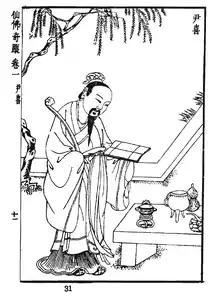
The name Yin Zhenren (尹真人, "Perfected [Master] Yin") combines the Chinese surname Yin with the standard Daoist Zhenren ("Perfected Person") honorific term for a transcendent.
One authorial hypothesis is that Yin Zhenren conceivably dictated the Xinging guizhi through planchette writing or spirit writing. The Daozang Daoist Canon contains several texts supposedly produced from spirit-writing. Some examples are the Daoji lingxian ji (道迹靈仙記, Record of the Traces of the Dao Left by Numinous Spirits and Immortals), the Minghe yuyin (鳴鶴餘音, Echoes of Cranes' Songs), and the Xuxian hanzao (徐仙翰藻, Literary Masterpieces of the Xu Immortals) (Despeux 2008: 428). If the Xinging guizhi was produced through spirit writing, two possible Daoist masters surnamed Yin are Yinxi (尹喜), a legendary gatekeeper who persuaded Laozi to write the Daodejing before leaving China to travel West, and Yin Zhiping (尹志平, 1169–1251), the second patriarch of Quanzhen School Daoism (Burton-Rose 2009: 11).
Besides the Xingming guizhi, another Neidan text retrospectively attributed to Yin Zhenren or Yin Pengtou (尹蓬頭, "Disheveled Yin") is the Liaoyang Dian Wenda Bian (廖陽殿問答編, Questions and Answers of the [Eastern Cloister of the] Liaoyang Hall). Min Yide (閔一得) edited it around 1830 from a manuscript preserved in the Qingyang Daoist Temple in Chengdu (Needham and Lu 1983: 224, 234).
Gaodi's lexical components are gao (高, "high; tall; eminent; surname"), di (弟,"younger brother; junior; [dizi 弟子] disciple"), and di (第, "indicator of ordinal numerals; sequence, order; rank, grade"). Gaodi (高弟, "brilliant disciple; high-level student") and gaodi (高第, "high-ranking [especially in imperial civil-service examinations]") were sometimes used interchangeably.
She Yongming's first edition 1615 preface explicitly refers to (尹真人高弟弟子, "Yin Zhenren's disciple Gao Di"—using the name Di (弟) and dizi (弟子, "disciple"). Both You Tong's 1669 (尹真人高弟) and Li Pu's 1670 (尹真人之高弟) descriptions can alternatively be read as "high disciple" or as "Gao Di". Zuo Yuanbiao's1622 forward (尹真人高第) writes Gao's given name as 第 instead of 弟. Needham and Lu translate Gao Di (高第) as a proper name (1983: 231).
One scholar tentatively identifies the Xingming guizhi disciple Gao Di with a Ming dynasty scholar. The 1739 History of Ming (juan 257) records that Gao Di (高第) received a jinshi degree in 1589 and opposed the eunuch dictator Wei Zhongxian (Skar 2002: 198).
Contents

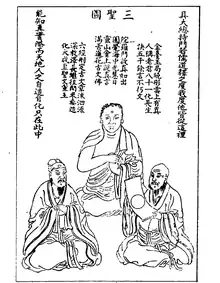
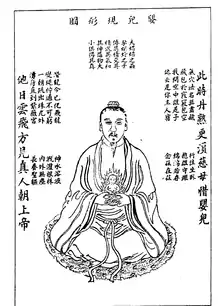
The syncretistic Xingming guizhi is notable for comprehensive explanations, numerous woodcut illustrations, and explicit depictions of the nine stages of transformation. The wide-ranging Xingming guizhi is praised by the historians of Chinese science Joseph Needham and Lu Gwei-djen as, "a treatise of substantial size which might be regarded as the Summa of physiological alchemy [neidan]." (1983: 229).
The Xingming guizhi text is divided into four ji (集, "collections of writings; books"): Yuan (元, "primary"), Heng (亨, "go smoothly"), Li (利, "benefit") and Zhen (貞, "loyal"), which is a Classical Chinese allusion to the first sentence of the Yijing commentary on Hexagram 1 Qian (乾, "force; creative"): "The Creative works sublime success, furthering through perseverance" [乾元亨利貞]. (tr. Wilhelm and Baynes 1967: 4). These four books present an overview of basic neidan principles.
Book 1 has twenty-three shuo (說, "explanations; discourses; narrations") that outline the foundations of Internal Alchemy. Books 2-4 give diverse koujue (口訣, "secret oral instructions") that explain neidan practices in more detail; each book contains three main chapters, organized in correspondence with the Quanzhen jiujie xuangong (九節玄功, Mysterious Practice in Nine Stages) of internal alchemical transformation. All four books contain tu (圖, "illustrations; diagrams; charts") accompanied by short texts, frequently in the form of rhymed poems (Darga 2008: 1107). The textual organization "outlines the adept's progress in four clear parts." Book 1 begins with defining basic concepts and clarifying terms; Book 2, called "nourishing the original source," deals with cultivating and strengthening one's physical energies; Book 3 establishes an active relationship between the physical and the heavenly, described as the "union of [the trigrams] qian (☰) and kun (☰)"; Book 4 describes liberation from the world, when the shengtai Sacred Embryo develops and grows, "goes beyond all, and merges with emptiness". (Kohn 2000: 545).
The Xingming guizhi quotes from Confucian, Lao-Zhuang, Daoist, and Buddhist sources.
One of the main concerns of the Xingming guizhi is to lead the adept through the multitude of alchemical methods and writings to the core of the true path of neidan. This core is to be sought at the basis of all phenomena and is proof of the undivided unity and the unchanging nature of the Dao. The author approaches this core from a variety of perspectives, employing a wealth of concepts but always returning to the central theme. He does not give any practical instructions for practicing inner alchemy, however; in fact, he dissociates himself from specific exercises, as these belong to the phenomenal domain from which he tries to lead away his readers. (Darga 2008: 1107)
In the Quanzhen lineages the Xingming guizhi is usually classified as belonging to the Beizong (北宗, Northern Lineage) or the Zhongpai (中派 Central Branch) of Ming and Qing neidan. Its ideas are mainly based on Zhang Boduan's (張伯端, 987?-1082) Wuzhen pian (Folios on Awakening to Reality / Perfection) and Li Daochun's (李道純, fl. 1288–1292) Zhonghe ji (中和集, The Book of Balance and Harmony), and are also closely related to other Quanzhen School neidan texts. (Darga 2008: 1107).
Despite the Xingming guizhi's detailed coverage of Daoist Internal Alchemy, such as a "wonderful list of the chief varieties of the 'three thousand six hundred' techniques [pangmen (旁門, lit. "side door", "improper means"]" practiced by men and women neidan adepts, many Western sinologists have misconstrued it. John Dudgeon (1895) mistook the text for a manual of gymnastics, while Richard Wilhelm and Carl Jung (1931) used it "iconographically without much understanding" (Needham and Lu 1983: 231). Wilhelm and Jung's The Secret of the Golden Flower used four Xingming guizhi illustrations— without citing the source—to depict the stages of meditation, for example, the uncredited Ying'er xianxing (嬰兒現形, Revealing the Sacred Embryo) illustration is on the first edition cover, although the book does not mention the Internal Alchemical shengtai ("sacred embryo, embryo of sagehood") concept.
Examples
The following four sample Xingming guizhi illustrations demonstrate the text's comprehensive treatment of Internal Alchemy. Two examples depict alchemical reaction-vessels and culturally symbolic animals, and two others show Daoist "inner landscape" diagrams of the human body.

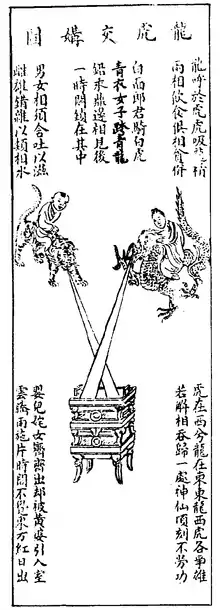


The first two examples, called the "Illustration of Bringing Together the Four Symbols" and "Illustration of the Marriage of the Dragon and the Tiger" both depict Chinese mythical animals and an alchemical ding cauldron, either round vessels with three legs or rectangular ones with four. In waidan Outer Alchemy, the ding laboratory cauldron was originally used to heat elixir ingredients, while in later neidan Outer Alchemy, Daoist practitioners semantically extended the word to mean the metaphorical cauldron allegedly located in the lower dantian of the human body, wherein an adept cultivated the Three Treasures of Jing ("Essence"), Qi ("Breath"), and Shen ("Spirit").
The Four Symbols are mythological creatures appearing among the Chinese constellations along the ecliptic, and viewed as the guardians of the four cardinal directions. The Black Tortoise (an entwined tortoise and snake) of the North shown on the bottom, represents water and the kidneys; the Vermilion Bird of the South on the top, represents fire and the heart; the Azure Dragon of the East on the right, represents wood and liver; and the White Tiger of the West shown on the left, represents metal and the lungs (Little 2000: 349). This Xingming guizhi directional representation of top as bottom and right as left is inverted, "like so much else in physiological alchemy" (Needham and Lu 1983: 58).
This Four Symbols illustration shows the symbolical animals of the four directions surrounding and influencing the bodily alchemical crucible, here labeled zhenyi (真意, "realized will"). The realized will is explained in the text as "the prime of the trigram qian [(乾, ☰,) three unbroken yang lines], the mother of the heavens and the earth, the root of yin and yang, the source of water and fire, the ancestor of the sun and moon, the font of the three materials [the heavens, the earth, and humanity], and the progenitor of the Five Phases." (Little 2000: 349). In the top right inscription, the word wulou (無漏, "not leaking"; or [Buddhist] "passionless", from Sanskrit anāsrava) refers to that which "normally 'leaks out' through the sense-organs and other parts of the body" (Needham and Lu 1983: 252)
The "Illustration of the Marriage of the Dragon and the Tiger" (tr. Little), or "The Love-Making of Dragon and Tiger" (tr. Needham and Lu), title uses jiaogou (交媾, have sexual intercourse; mate"). The Azure Dragon, symbol of yang, and the White Tiger, symbol of yin, are shown infusing their energies into the alchemical crucible. A girl dressed in blue-green robes rides the dragon, symbol of yin within yang, while a white-faced boy rides the tiger, symbol of yang within yin. (Needham and Lu 1983: 104). These images suggest the trigrams li (離, ☲, two unbroken yang lines enclosing a broken yin line) and kan (坎, ☵, two broken yin lines enclosing an unbroken yang line), which represent toxic mercury and lead, the two fundamental elements transformed in Inner Alchemy. (Little 2000: 349). The dragon and tiger symbolizing the Yang and Yin was shown on many old Chinese numismatic charms and amulets (Needham and Lu 1983: 95).
The last two examples, called the Illustration of Broad Illumination and the Illustration of Reverse Illumination—or "Universal Radiance" and "The Glory of Reversion" (Needham and Lu)—show the inner landscapes of the anterior and posterior human body.
The front Illustration of Broad Illumination depicts a neidan meditator sitting cross-legged, and shows three circles. His right hand holds a hare enclosed in a circle, symbolizing of the mythological moon rabbit, and his left hand holds a crow enclosed in a circle, an ancient symbol of the three-legged sun crow. On his forehead the three-character phrase he xingming (和性命, "to join endowment and vitality") is enclosed in another circle. These three circles represent the yang and yin energies of the body to the left and the right, and their union in the center. The crescent shown on the meditator's abdomen represents the alchemical reaction vessel in the lower dantian ("cinnabar field; energy center") (Little 2000: 348). However, the 1615 first edition Xingming guizhi more complexly pictured the crescent above a rectangle and a ding crucible in the lower dantian (see Wellcome Collection under External links). According to Needham and Lu, this illustration shows "the triumphant adept with the sun in one hand and the moon in the other, Yin and Yang united" within the neidan elixir; and in this context, and the dan in dantian means "vital internal warmth", thus, dantian could be thought of as production centers of "animal heat" (1983: 95, 38).
The back Illustration of Reverse Illumination shows the vertebral column, which is flanked by the (anatomically misplaced) "kidneys" in the lower back; which are respectively labeled as longhuo (龍火, "dragon fire") on the right, a symbol of yang energy within the yin side of the body, and hushui (虎水, "tiger water") on the left, a symbol of yin energy within the yang side of the body. The head circle, which corresponds to the "to join endowment and vitality" above, encloses the word yuanshen (元神, "original spirit"), one of the sanyuan (三元, "three origins"), along with the yuanjing (元精, "original essence" and yuanqi (元氣, "original breath"). (Little 2000: 348-349).0
This Reverse Illumination drawing shows twenty-four "vertebra", labeled with the traditional Chinese medical acupoint names for fourteen of the twenty-eight points on the Dumai (督脈) Governing Vessel, from GV-1 Changqiang (長強, Long and Strong) to GV-14 Dazhui (大椎, Great Vertebra), between the coccyx and the anus. This location is associated with the ancient Daoist sexual theory of male avoidance of ejaculation, called Huanjing bunao (還精補腦, "returning the semen to replenish the brain"); Daoist physiologists imagined that unejaculated jing (精, " semen; [medical] essence of life") could rise up the spine into the brain in order increase health and longevity (cf. the Indian susumna channel). The common method of preventing ejaculation was to apply pressure on the perineum, halfway between the anus and the scrotum, resulting in retrograde ejaculation redirecting semen into the urinary bladder, where it was subsequently voided. (Needham and Lu 1983: 231)
Gallery
Click to enlarge, more images here.
![Washing the Heart-Mind and Storing [the Secretions] Inwardly 洗心退藏圖](../I/%E6%80%A7%E5%91%BD%E5%9C%AD%E6%97%A8_%E6%B4%97%E5%BF%83%E9%80%80%E8%97%8F%E5%9C%96.png.webp) Washing the Heart-Mind and Storing [the Secretions] Inwardly 洗心退藏圖
Washing the Heart-Mind and Storing [the Secretions] Inwardly 洗心退藏圖 The Dharma Wheel Turns Itself 法輪自轉圖
The Dharma Wheel Turns Itself 法輪自轉圖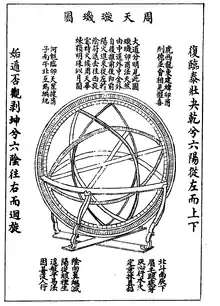 Armillary Sphere 周天璇璣圖
Armillary Sphere 周天璇璣圖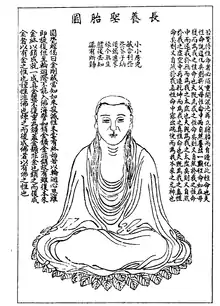 Nurturing the Holy Embryo 長養聖胎圖
Nurturing the Holy Embryo 長養聖胎圖 Escaping from the Sea of Suffering 出離苦海圖
Escaping from the Sea of Suffering 出離苦海圖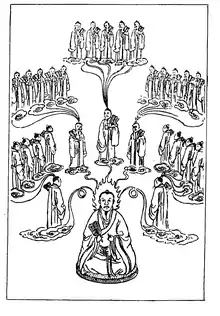 Transforming the Body Multiplied by Five 化身五五圖
Transforming the Body Multiplied by Five 化身五五圖 Riding the Phoenix Up into the Clouds 跨鳳凌霄圖
Riding the Phoenix Up into the Clouds 跨鳳凌霄圖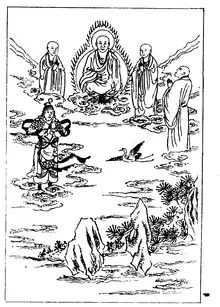 Transcending the Three Realms 超出三界圖
Transcending the Three Realms 超出三界圖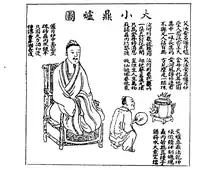 The Greater Cauldron and the Lesser Furnace 大小鼎爐圖
The Greater Cauldron and the Lesser Furnace 大小鼎爐圖 The Inner and Outer Elixirs 內外二藥圖
The Inner and Outer Elixirs 內外二藥圖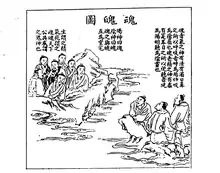 The Hun and Po Souls 魂魄圖
The Hun and Po Souls 魂魄圖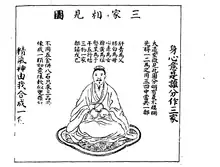 The Three Vitalities Meeting 三家相見圖
The Three Vitalities Meeting 三家相見圖 Guanyin’s Esoteric Incantation 觀音密呪圖
Guanyin’s Esoteric Incantation 觀音密呪圖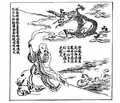 Subduing the Dragon 降龍圖
Subduing the Dragon 降龍圖 Collecting Fire and Transporting Gold 聚火載金圖
Collecting Fire and Transporting Gold 聚火載金圖 Refining Form in the True Void 真空煉形
Refining Form in the True Void 真空煉形
References
- Bishop, Tom (2016), Wenlin Software for learning Chinese, version 4.3.2.
- Bock-Möbius, Imke (2012), Qigong Meets Quantum Physics, Lulu.
- Burton-Rose, Daniel (2009), Integrating Inner Alchemy into Late Ming Cultural History A Contextualization and Annotated Translation of Principles of the Innate Disposition and the Lifespan (Xingming guizhi 性命圭旨) (1615), Master's thesis, Department of Chinese Studies, Boulder, University of Colorado.
- Darga, Martina (2008), "Xingming guizhi 性命圭旨, Principles of Balanced Cultivation of Inner Nature and Vital Force", in Pregadio, Fabrizio (ed.), The Encyclopedia of Taoism, two volumes, Routledge, 1106–1107.
- Despeux, Catherine (2008), "Fuji 扶乩 planchette writing; spirit writing," in The Encyclopedia of Taoism, ed. Fabrizio Pregadio, Routledge, 428–429.
- Despeux, Catherine (2016), "Symbolic pregnancy and the sexual identity of Taoist adepts", in Anna Andreeva and Dominic Steavu (eds.), Transforming the Void. Embryological Discourse and Reproductive Imagery in East Asian Religions, Brill, 147–185.
- Despeux, Catherine (2019), Taoism and Self Knowledge: The Chart for the Cultivation of Perfection (Xiuzhen tu), Brill.
- Dudgeon, John (1895), "Kung-Fu, or Tauist Medical Gymnastics", Journal of the Peking Oriental Society 3.4: 341–565.
- Esposito, Monica (2001), "Longmen Taoism in Qing China: Doctrinal Ideal and Local Reality," Journal of Chinese Religions 29.1: 191–231.
- Esposito, Monica (2008), "Shuangxiu 雙修, joint cultivation", in Pregadio, Fabrizio (ed.), The Encyclopedia of Taoism, two volumes, Routledge, 906–907.
- Kohn, Livia (2000). [Review of Das alchemistische Buch von innerem Wesen und Lebensenergie : Xingming guizhi, by M. Darga]. Revue Bibliographique de Sinologie 18: 545.
- Komjathy, Louis, (2011), "The Daoist Mystical Body," in Cattoi, T., McDaniel, J. (eds), Perceiving the Divine through the Human Body, Palgrave Macmillan.
- Kroll, Paul W. (2017), A Student's Dictionary of Classical and Medieval Chinese (rev. ed.), E.J. Brill.
- Little, Stephen (2000), Taoism and the Arts of China, with Shawn Eichman, Art Institute of Chicago.
- Liu Ts'unyan (1970), "Taoist Self-Cultivation in Ming Thought," in de Bary, Theodore (ed.), Self and Society in Ming Thought, Columbia University Press, 291–330. 306;
- Liu Xun 劉迅 (2016), "An Intoning Immortal at the West Lake - 西泠詠仙——晚清江南陳文述的道教修行: Chen Wenshu and His Daoist Pursuits in Late Qing Jiangnan", Cahiers d’Extrême-Asie 25: 77–112.
- Luo Zhufeng 羅竹風, chief ed., (1994), Hanyu da cidian ("Comprehensive Dictionary of Chinese"), 13 vols. Shanghai cishu chubanshe.
- Needham, Joseph and Lu Gwei-Djen (1983), Science and Civilisation in China. Vol. V: Chemistry and Chemical Technology, Part 5: Spagyrical Discovery and Invention: Physiological Alchemy, Cambridge University Press.
- Pregadio, Fabrizio (2014), "Destiny, Vital Force, or Existence? On the Meanings of Ming in Daoist Internal Alchemy and Its Relation to Xing or Human Nature," Daoism: Religion, History and Society [道教研究學報: 宗教, 歷史與社會] 6: 157–218.
- Skar, Lowell (2002), "[Book Review of] Martina Darga Das alchemistische Buch von innerem Wesen und Lebensenergie," Journal of Chinese Religions 30.1: 197–198.
- Wilhelm, Richard and Jung, Carl G. (1931), The Secret of the Golden Flower; a Chinese Book of Life, tr. Cary F. Baynes, Kegan Paul.
- Wilhelm, Richard (1967), The I Ching or Book of Changes, Cary Baynes, trans., 3rd ed., Pantheon Books.
- Yu, Anthony C., tr. (2012), The Journey to the West, Revised Edition, Volume 1, University of Chicago Press.
External links
- 性命圭旨, Xingming guizhi, Wikisource edition.
- Xing ming gui zhi : si juan 性命圭旨: 四卷, 1615 edition, Library of Congress.
- 性命双修万神圭旨, Chinese Text Project.
- Digital Images from the Xingming guizhi, 1615 edition, Wellcome Collection.
- 性命雙修萬神圭旨 :4卷, 1615 edition, Harvard-Yenching Library
- 性命圭旨, Navigable digital edition Xingming guizhi, Internet Archive
